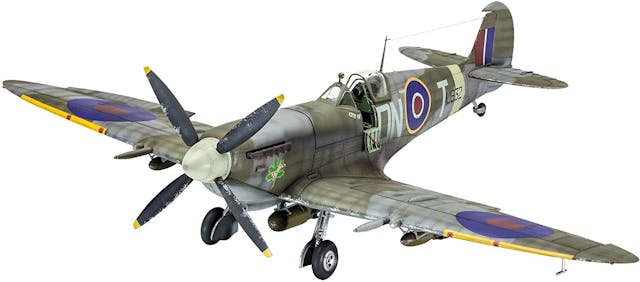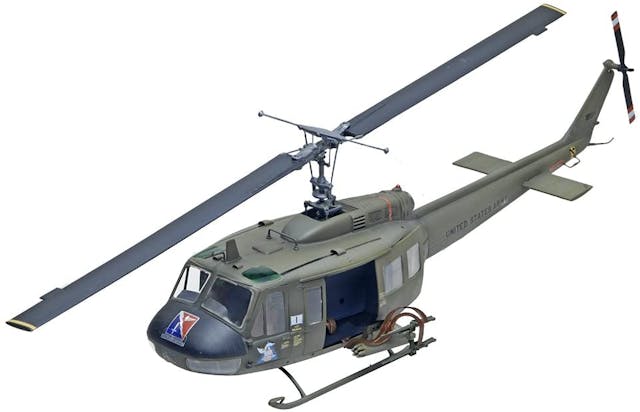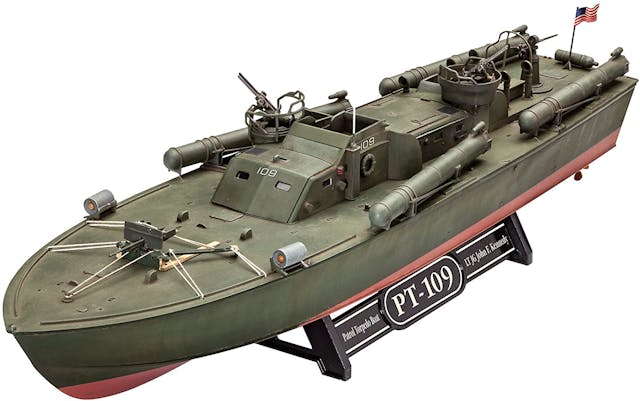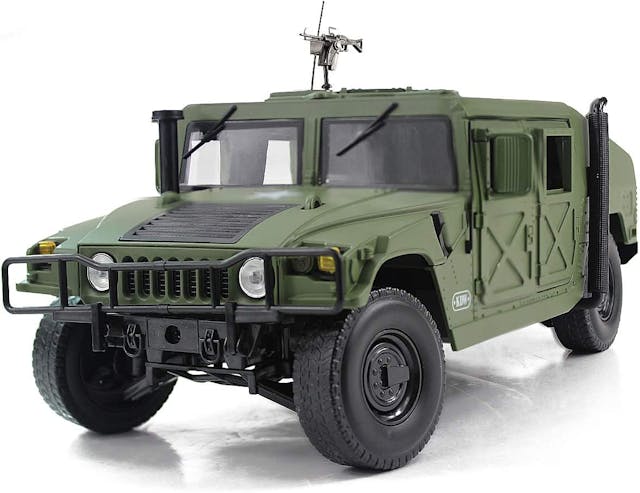Ten-hut! These 10 military scale models emit serious shelf appeal
As the world speeds headlong into 2021, you may find yourself entrenched in the frenzy of a digital age, one in which news, ideas, and entertainment fly at fiber-optic speeds. Looking for an antidote to the madness? Building scale models may offer a measure of zen for those who enjoy working with their hands but don’t have the space, budget, or desire to tear down an engine or restore a full-scale classic.
Whether you’re out of work, working from home, or soon returning to the office, scale models, particularly of the military variety, are wallet-friendly conversation starters worth showing off to in-person or on-screen friends. To help narrow your search, we’ve curated this list of 10 planes, boats, and automobiles with show-stopper looks and legendary service histories. Given the wide range of complexity and cost, however, we’ll leave the final choice of kit up to you.
Fokker Dr.1 PL

Barely a decade after the Wright Brothers made their first flights at Kitty Hawk in 1903, men were learning how to spy on, bomb, and fight one another from the air during World War I. By the end of the war, an infamous German pilot known as the “Red Baron” was terrorizing the skies in a red Fokker Triplane.
Its stacked, three-winged design is certainly polarizing, but the Fokker actually wasn’t the first to use the configuration. That distinction belongs to the British Sopwith Triplane, which the Germans scrambled to replicate after the design drew the admiration of the Red Baron himself. To avoid side glances or awkward talks with HR, consider building the Fokker and the Sopwith to complete the full picture.
Spitfire

Aviation technology in the second World War improved exponentially beyond that in the first. Luckily for the Brits, in that 21-year inter-war period, aircraft talent R.J. Mitchell and the renowned designers at Supermarine were hard at work creating a Merlin V-12-powered monoplane for the RAF that was eventually called the Spitfire. These sturdy fighters bravely fended off the Luftwaffe time and again during the Battle of Britain, thus setting the stage for the Allied forces to assemble for D-Day.
Legendary as they were, Spitfires weren’t without their flaws; for instance, the carburetors tended to starve the Merlin of fuel during aggressive dives. Thanks to one unsung hero, and the addition of anti-g modifications to newer carbs, the issue was rectified by 1941. The landscape of Britain (and the world) would look much different today if it weren’t for the Spitfire, and something about the Spit—even in scale model form—is enough to get Hans Zimmer’s “Supermarine” pumping through our skulls.
P-51 Mustang

At the very core of the USAAF’s fighting stock was the long-ranged P-51 Mustang, rolled out in A, B, C and D iterations beginning in 1940. They’re famous for their unpainted skins, but not all P-51s flaunted the bare-metal look. Early P-51 Mustangs were painted in camouflage to help parked planes escape notice from the air. However, once momentum shifted in the skies and the Allies began to establish superiority, the additional weight and production time involved in painting each plane became impractical.
Whether camo’d or not, these long-range fighters were ideal cover for U.S. bombing raids. Early versions of the P-51 used the Merlin V-12, though eventually the P-51D switched to a Packard-made V-12. If you’ve never had the thrill of being airborne in one, or heard one fire up in the flesh, your imagination and this glistening desk trophy will have to do for now.
UH-1 Iroquois (Huey)

In 1956, the Huey was a welcome development in the world of rotorcraft due to its agility under load and powerful Lycoming turboshaft engine. UH-1Ds were armed and brought the fight, while UH-1Vs were stringently spec’d for medivac duty. For many, the sight of a descending Huey meant salvation; today, it’s a revered piece of machinery in the memory of many veterans.
Because they’ve been in operation all over the world, Hueys elicit strong emotion across an unusually wide range of countries. Some hear the chop of their blades and think of angels; for others, the sound recalls “Fortunate Son” and their favorite military movies. The best part about a scale model with two rotors? It’s a low-key fidget spinner for adults, embarrassment not included.
Patrol torpedo boat PT-109

Any craft that earned titles such as “the mosquito fleet” and “devil boats” from the fearless Japanese must be formidable indeed. Though armed to the hilt with four Bliss-Leavitt Mark 8 torpedoes and weighing 3150 pounds apiece, these boats could fly thanks to not one but three Packard V-12s. Their top speed was roughly 41 knots, or approximately 47 mph.
PT-109, shown here, was piloted by a young John F. Kennedy, who eventually found his way into combat action in the Southern Pacific against his father’s desires. In the wee hours of 2 a.m. on August 2, 1943, PT-109 was struck by the much larger Japanese destroyer Amagiri. The little U.S. vessel erupted in a fiery explosion. Lieutenant Kennedy and other survivors clung to the hull of the sinking ship as long as they could before swimming for miles together in search of landfall. They found solid ground but were marooned for three days until a few Solomon Island scouts discovered them.
BMW R75 and Sidecar

Chariot of choice for the Afrika Korps, the R75 and Sidecar were the result of a special request put into BMW by the German Army starting in 1938. Equipped with an all-new OHV 745-cc engine and a robust cooling system, the R75 had several other tricks that helped it thrive in North Africa. A locking rear differential sat between the bike’s rear wheel and the sidecar’s axle, and its two different gear modes for better performance on- or off-road were semi-revolutionary for this style of machine. The R75 gave the Nazis a nimble fighting unit in the sand, even if its 900-pound weight demanded hydraulic brakes. Production at Eisenach eventually ceased when an Allied bombing raid put the plant out of commission in 1944, but not before these BMWs influenced other military designs like the Harley-Davidson XA and Indian 841.
M4 Sherman

Owning a tank is hard. Owning a scale model of a tank? Less so. The Sherman has been an American military staple since it entered service in 1942, but not necessarily because it possessed a pound-for-pound battlefield advantage. In most scenarios the Shermans weren’t better, faster, or stronger than their enemy equivalents, but the sheer volume that the American industrial machine could put onto the field could simply overwhelm the opposition into submission. Shermans were the most-produced tank in American history, surpassed on the global level only by the Soviet Union’s T-34. Appropriately, there is a vast selection of Sherman scale models available online at varying levels of difficulty.
Willys MB

It’s an oldie but a goodie. The MB’s performance drew glowing praise from military leaders like Generals Eisenhower and Marshall in-period . Today, the reputation of the Willys MB precedes it, earning the jeep a place in the hearts and minds of children all over America decades after it left active duty. After the war, Jeep put its 4×4 runabout into civilian production in one of the most direct and successful translations of military transportation tech to private life.
VW Kübelwagen Type 82

Fans familiar with Volkswagen and the lineage behind the VW Thing will be acquainted with the “bucket-seat car” designed by Ferdinand Porsche. Like their opponents across the Atlantic, the Germans recognized the advantage of a competent light-duty vehicle that was capable off-road. Essentially, Kübelwagens were Beetles with a little extra beef. Although they were exclusively rear-wheel-drive, the Type 82s had limited-slip differentials and weighed nearly a half-ton less than the Willys MB, making the VWs spry little buggies with better power-to-weight ratios.
In a similar fashion to the Willys MB, the Type 82 found success in the civilian sector after the war. Today its international descendents include the Thing in America, the Safari in Mexico, and the Trekker in the U.K.
Humvee

Back when AM General’s HMMWV (Humvee) officially entered service in 1983, it would have been incredibly hard to believe that this military-born and -bred icon would become so civilized (need we mention the nameplate’s all electric-future as the swanky Hummer EV?).
The Humvee’s fighting career largely took place in the Gulf, where it established a love-it-or-hate-it reputation. Humvees weren’t the most reliable, and their vulnerability to explosives placed underneath them represented serious cause for concern. After a run of nearly 30 years, the U.S. government accepted that the Humvee’s best days were over. Retirement was imminent and phase-out commenced. While the civilian model’s success pales in comparison to the Jeep’s, the Hummer name still carries weight in the minds of modern-day consumers and initial demand for a resurrected model appears strong.

